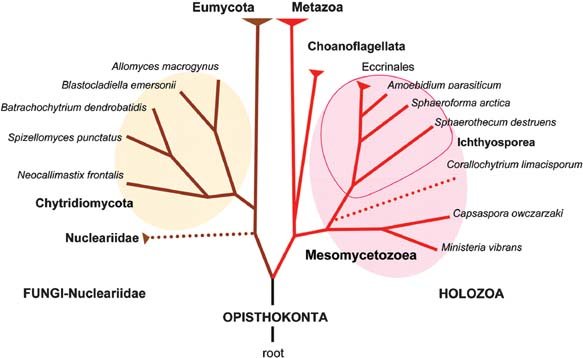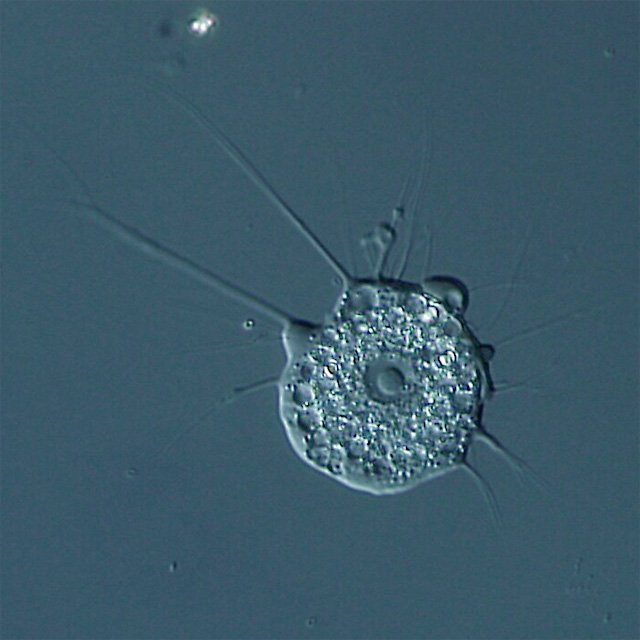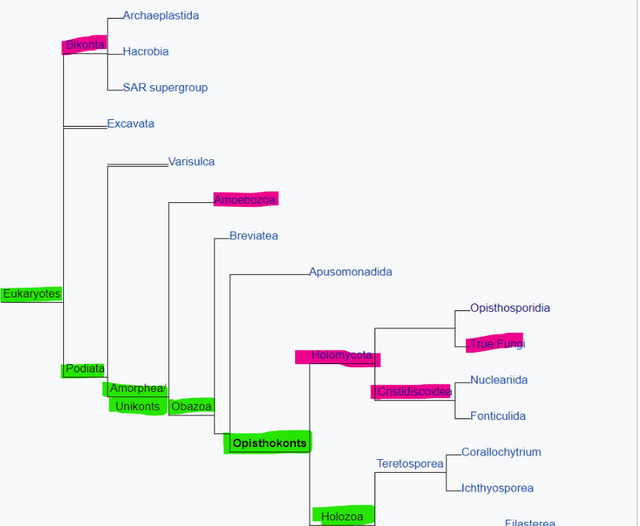Tree of Life: Opisthokonta to Holozoa
If you want to start this journey from the beginning, here are the previous episodes:
tl;dr
Here's a refresher. The tree of life is huge and more complex than you could possibly imagine, built off discoveries and research from countless people over countless years. You can see much of it in This interactive map I'm exploring, from the dawn of life all the way to humans.
The second post we looked at the 3 domains that all life as we know it fits into, and how bacteria and archaea actually look like the same thing, but are actually fundamentally very different. Eukaryota are different again, but gave rise to everything we pretty much recognize as life; plants, fungi, animals and so on.
The third post, simply put, looks at where plants diverge from animals, showing how archaea are bizarrely closer to humans than bacteria, and where Eukaryota begun, in the form of protists.
Ectasian period
As we travel through time, we arrive at the Ectasian Period, around 1,400-1,200 million years ago. At this point, life diverges once more.
But we're still in the flagella-wielding time of life; single celled organisms that propel themselves with wild little tails.
Opisthokont

You may have noticed the suffix kont appearing a lot. kont comes from the greek word 'kontos' or 'pole' referring to the flagellum, though I also learnt it's a rather vulgar term for... well, look it up.
opisthios refers to 'rear', so Opisthokont is simply referring to the 'rear-end tail', but the group is also known as Choanozoa, or 'funnel animal'.
Together this is a broad group of life that includes Animals and fungi. But not plants. If you remember, plants broke off in the family tree at 'bikonts', but we are now all under the 'unikont' branch; fungi truly are closer to humans than plants.
Opisthokonts are divided into two groups; holomycota and holozoa. Etymologists out there might be twitching with guesses to what these mean. mycota refers to fungi, and zoa refers to animals.
But it's never as simple as that!
Holomycota
Holomycota actually refers to fungi and organisms that are not fungi, but closer to fungi than animals. So this includes 'true fungi', but also Cristidiscoidea.

At this point we're actually in kind of murky waters. The taxonomic ranks are vague and unsorted, often simply 'unranked'. This is an area so close to the split between fungi and animals that it's hard to produce clear results.
however, one proposed organism that fits into this category is the Nuclearia thermophila, a tiny species found in a lake in Japan.
Holozoa
This is the direction we want to be going! Holozoa formed around 1 billion years ago, during the Stenian period and consists of 1.3 million species, including us... somewhere.

Note that Holozoa doesn't mean 'animals'; it's a group that includes animals but also things that are not animals but closer to animals than fungi.
An example of this are the choanoflagellates, the closest living relatives to animals. These are unicellular organisms have a striking resemblance to sponges, and were thought to be so as recently as the late 19th century.
In the above picture you see holozoa also splits into something called teretosporea. We don't need to go down there, but it's another example of 'proposed' ranks in taxonomy, a testament to how much we just don't know.
In summary
We split from the plants with fungi as Unikonts. We split from amoeba and joined fungi at the Opisthokont level. Here, fungi and we split ways via holomycota and holozoa.
Holomycota includes fungi and fungi-like things, whereas holozoa includes animals and animal-like things. Finally the journey is starting to sound more recognizeable! But we're still a billion years in the past, and modern humans are barely 200,000 years old so... quite a way to go yet!
Note: Though this isn't exactly a cool, popular subject, rather just something I happen to be digging deeply into, It's quite disappointing to see there are very few sources and very little information freely accessible into these taxonomic ranks. Outside of brief wikipedia pages and a bunch of very obsolete, broken websites seemingly from the 90's, there's really not much out there for the curious mind to explore!

All images CC0 Licensed
References: Ectasian period | Opisthokont | Nuclearia Thermophilia | Choanoflagellate | Holomycota | Holozoa
quite an informative post. but then i wonder how people that are in this fields get to remember and differentiate these scientific names
It's probably not as bad once you understand the patterns and etymology. For me in music for example, there are hundreds of words based in Italian, Latin, German that you just have to kinda know; just an extension of your vocab I guess
There are no journals on the same? Or they are only accessible to afew people?
There are surely journals using this data, but journals aren't there to teach you and indeed harder to come by for the layman wanting to learn. And this is certainly nothing I learnt in school!
Wow! This is an in-depth survey. I've read about the ectasian period, in passing though.
But there's something I can't remember again: Was it during this period that the red algae emerged? I heard they were the first true multicelled organism.
Nice piece buddy